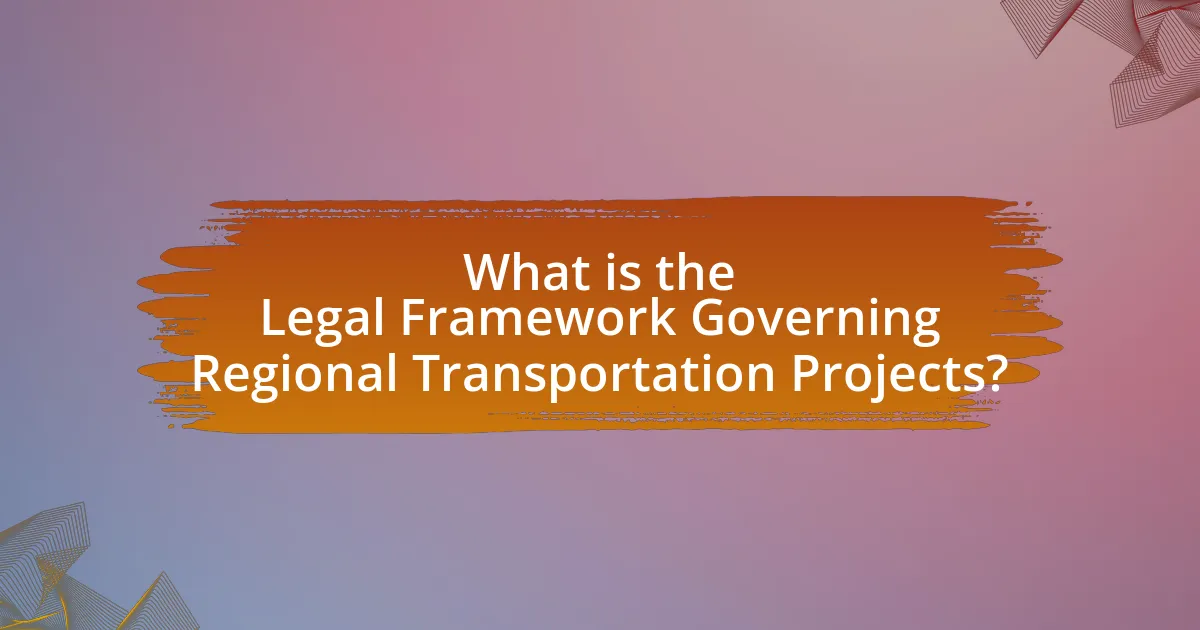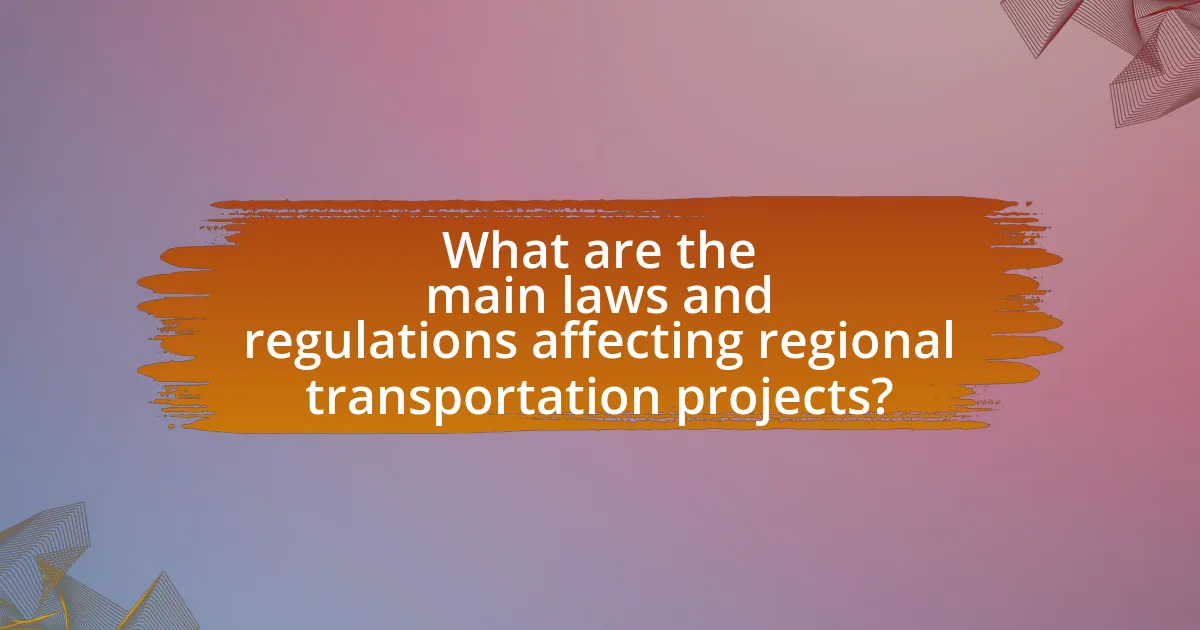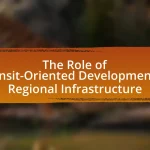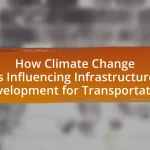The article analyzes the legal framework governing regional transportation projects, highlighting the interplay of federal, state, and local laws that dictate planning, funding, and implementation processes. Key legislation, such as the National Environmental Policy Act (NEPA) and the Federal-Aid Highway Act, establishes essential guidelines for environmental assessments and funding mechanisms. The article discusses the impact of these regulations on project timelines, compliance requirements, and stakeholder engagement, emphasizing the importance of understanding legal obligations to mitigate risks and enhance project success. Additionally, it outlines best practices for navigating the complex legal landscape, ensuring adherence to regulatory standards, and fostering effective communication among stakeholders.

What is the Legal Framework Governing Regional Transportation Projects?
The legal framework governing regional transportation projects primarily consists of federal, state, and local laws, regulations, and policies that guide planning, funding, and implementation. At the federal level, key legislation includes the National Environmental Policy Act (NEPA), which mandates environmental assessments for major projects, and the Federal-Aid Highway Act, which provides funding mechanisms for transportation infrastructure. State laws often complement federal regulations by establishing specific guidelines for project approval, funding allocation, and compliance with local zoning and environmental standards. Local governments also play a crucial role by enacting ordinances and plans that align with regional transportation goals. This multi-tiered legal structure ensures that transportation projects meet safety, environmental, and community needs while facilitating coordination among various stakeholders.
How does the legal framework impact regional transportation projects?
The legal framework significantly impacts regional transportation projects by establishing regulations, funding mechanisms, and compliance requirements that govern project planning and execution. These laws dictate the processes for environmental assessments, land use, and public engagement, which can either facilitate or hinder project timelines and costs. For instance, the National Environmental Policy Act (NEPA) mandates environmental reviews for federally funded projects, potentially extending project timelines due to compliance requirements. Additionally, state and local laws may impose specific zoning regulations that affect land acquisition and project design, further influencing the feasibility and scope of transportation initiatives.
What are the key components of this legal framework?
The key components of the legal framework governing regional transportation projects include regulatory compliance, funding mechanisms, environmental assessments, and stakeholder engagement. Regulatory compliance ensures that projects adhere to federal, state, and local laws, such as the National Environmental Policy Act, which mandates environmental reviews. Funding mechanisms involve federal grants, state allocations, and public-private partnerships, which are essential for financing infrastructure. Environmental assessments evaluate the potential impacts of projects on ecosystems and communities, ensuring sustainable development. Lastly, stakeholder engagement involves collaboration with local communities, government entities, and interest groups to address concerns and gather input, fostering transparency and public support.
How do regulations shape project planning and execution?
Regulations significantly shape project planning and execution by establishing mandatory guidelines that govern various aspects of project development. These regulations dictate compliance with safety standards, environmental protections, and zoning laws, which directly influence project timelines, budgets, and resource allocation. For instance, the National Environmental Policy Act (NEPA) requires federal agencies to assess environmental impacts before project approval, thereby extending planning phases and necessitating additional resources for compliance. Furthermore, local zoning regulations can restrict project scope and design, compelling planners to adapt their strategies to meet legal requirements. This regulatory framework ensures that projects align with public interests and legal standards, ultimately affecting their feasibility and success.
Why is understanding this legal framework important?
Understanding the legal framework governing regional transportation projects is crucial because it ensures compliance with regulations, facilitates project approval, and mitigates legal risks. This framework outlines the necessary procedures, stakeholder responsibilities, and funding mechanisms, which are essential for the successful execution of transportation initiatives. For instance, adherence to the National Environmental Policy Act (NEPA) is required for federal projects, mandating environmental assessments that can significantly impact project timelines and costs. Therefore, a comprehensive understanding of this legal framework enables stakeholders to navigate complexities effectively, ensuring that projects are completed on time and within budget while minimizing potential legal challenges.
What risks are associated with non-compliance?
Non-compliance with legal frameworks governing regional transportation projects poses significant risks, including legal penalties, financial losses, and project delays. Legal penalties can arise from fines imposed by regulatory bodies for failing to adhere to established laws and regulations, which can amount to millions of dollars depending on the severity of the violation. Financial losses may occur due to increased costs associated with rework, litigation, or loss of funding, as stakeholders may withdraw support if compliance is not maintained. Additionally, project delays can result from the need to address compliance issues, leading to extended timelines and potential loss of public trust. These risks underscore the importance of adhering to legal requirements in transportation project management.
How can stakeholders benefit from a clear understanding of the legal framework?
Stakeholders can benefit from a clear understanding of the legal framework by ensuring compliance with regulations, which minimizes legal risks and enhances project success. A comprehensive grasp of laws governing regional transportation projects allows stakeholders to navigate complex legal requirements effectively, facilitating smoother project execution. For instance, knowledge of environmental regulations can help stakeholders avoid costly delays and penalties associated with non-compliance. Additionally, understanding contractual obligations and liability issues enables stakeholders to make informed decisions, fostering collaboration and reducing disputes. This clarity ultimately leads to more efficient resource allocation and better project outcomes.

What are the main laws and regulations affecting regional transportation projects?
The main laws and regulations affecting regional transportation projects include the National Environmental Policy Act (NEPA), the Clean Air Act, and the Federal-Aid Highway Act. NEPA requires federal agencies to assess the environmental impacts of their proposed actions, ensuring that transportation projects consider ecological consequences. The Clean Air Act mandates that transportation projects comply with air quality standards, promoting cleaner air through regulatory measures. The Federal-Aid Highway Act provides federal funding for highway construction and maintenance, establishing guidelines for project eligibility and compliance with safety standards. These laws collectively shape the planning, funding, and execution of regional transportation initiatives, ensuring they meet environmental, safety, and funding criteria.
Which federal laws play a significant role?
The federal laws that play a significant role in regional transportation projects include the National Environmental Policy Act (NEPA), the Clean Air Act (CAA), and the Federal-Aid Highway Act. NEPA requires federal agencies to assess the environmental impacts of their proposed actions, ensuring that environmental factors are considered in decision-making. The CAA establishes air quality standards and regulates emissions, impacting transportation planning and project approvals. The Federal-Aid Highway Act provides funding for highway construction and maintenance, shaping the development of transportation infrastructure. These laws collectively influence the planning, funding, and environmental compliance of regional transportation initiatives.
What is the National Environmental Policy Act (NEPA) and its relevance?
The National Environmental Policy Act (NEPA) is a United States federal law enacted in 1969 that requires federal agencies to assess the environmental effects of their proposed actions before making decisions. NEPA is relevant because it establishes a framework for environmental review, ensuring that potential impacts on the environment are considered in the planning and decision-making processes for projects, including regional transportation initiatives. The act mandates the preparation of Environmental Assessments (EAs) and Environmental Impact Statements (EISs), which analyze the potential environmental consequences and explore alternatives, thereby promoting informed decision-making and public involvement in federal projects.
How does the Federal Aid Highway Act influence funding?
The Federal Aid Highway Act significantly influences funding by establishing a federal-state partnership that allocates federal funds for the construction and maintenance of highways. This act, first enacted in 1956, created the Highway Trust Fund, which finances federal-aid highway projects through fuel taxes. As a result, states receive matching funds from the federal government, which incentivizes them to invest in their highway infrastructure. In 2021, the Infrastructure Investment and Jobs Act further expanded funding, providing $110 billion for roads, bridges, and major projects, demonstrating the act’s ongoing impact on transportation funding.
What state and local regulations must be considered?
State and local regulations that must be considered include zoning laws, environmental regulations, and transportation planning requirements. Zoning laws dictate land use and development standards, which can affect the location and design of transportation projects. Environmental regulations, such as the National Environmental Policy Act (NEPA) and state-specific environmental quality acts, require assessments of potential impacts on ecosystems and communities. Transportation planning requirements, often governed by state departments of transportation, mandate compliance with regional transportation plans and funding eligibility criteria. These regulations ensure that projects align with community goals and legal standards, facilitating sustainable development and public safety.
How do state laws differ from federal regulations?
State laws differ from federal regulations primarily in their scope and authority; state laws govern specific issues within a state, while federal regulations apply nationwide. For example, transportation projects may be subject to state-specific environmental regulations that can vary significantly from federal standards set by agencies like the Environmental Protection Agency. This divergence allows states to tailor laws to local needs, but it can also lead to inconsistencies in how transportation projects are managed across different states.
What role do local ordinances play in project approval?
Local ordinances are critical in project approval as they establish specific regulations and guidelines that projects must adhere to within a municipality. These ordinances dictate zoning laws, land use, building codes, and environmental standards, which directly influence whether a project can proceed. For instance, a transportation project must comply with local zoning ordinances that determine the allowable land use in the area, ensuring that the project aligns with community planning goals. Additionally, local ordinances often require public hearings and input from residents, which can affect the approval process by incorporating community feedback into decision-making. This regulatory framework ensures that projects meet local standards and address community concerns, ultimately shaping the development landscape.

How do stakeholders navigate the legal framework for regional transportation projects?
Stakeholders navigate the legal framework for regional transportation projects by engaging in comprehensive planning, compliance with regulations, and collaboration with governmental agencies. They begin by identifying relevant laws, such as the National Environmental Policy Act (NEPA), which mandates environmental assessments for federally funded projects. Stakeholders also conduct public consultations to gather input and ensure transparency, which is crucial for meeting legal requirements and fostering community support. Additionally, they often utilize legal counsel to interpret complex regulations and navigate permitting processes, ensuring adherence to local, state, and federal laws. This structured approach allows stakeholders to effectively manage risks and align project goals with legal obligations, ultimately facilitating successful project implementation.
What strategies can stakeholders employ for compliance?
Stakeholders can employ several strategies for compliance, including establishing clear communication channels, conducting regular training sessions, and implementing robust monitoring systems. Clear communication ensures that all parties understand legal requirements and expectations, while training sessions equip stakeholders with the necessary knowledge to adhere to regulations. Monitoring systems, such as audits and compliance checks, help identify potential issues early and ensure ongoing adherence to legal standards. These strategies are essential for maintaining compliance in the complex legal framework governing regional transportation projects, as evidenced by successful case studies where proactive compliance measures led to reduced legal disputes and enhanced project efficiency.
How can effective communication with legal advisors enhance project outcomes?
Effective communication with legal advisors enhances project outcomes by ensuring compliance with regulations and minimizing legal risks. When project teams engage in clear and consistent dialogue with legal advisors, they can identify potential legal issues early, allowing for timely adjustments to project plans. This proactive approach not only streamlines decision-making but also fosters a collaborative environment where legal considerations are integrated into project strategies. Studies show that projects with strong legal oversight experience fewer delays and cost overruns, highlighting the importance of effective communication in achieving successful project completion.
What best practices should be followed during project planning?
Best practices during project planning include defining clear objectives, engaging stakeholders, and establishing a realistic timeline. Clear objectives guide the project direction and ensure alignment with overall goals, while stakeholder engagement fosters collaboration and addresses concerns early on. Establishing a realistic timeline helps in resource allocation and sets achievable milestones. According to the Project Management Institute, projects with defined objectives and stakeholder involvement are 20% more likely to succeed, highlighting the importance of these practices in effective project planning.
What common challenges do stakeholders face in this legal landscape?
Stakeholders in the legal landscape governing regional transportation projects commonly face challenges such as regulatory compliance, funding limitations, and stakeholder coordination. Regulatory compliance involves navigating complex federal, state, and local laws, which can vary significantly and create confusion. Funding limitations often arise due to budget constraints and competition for financial resources, making it difficult to secure necessary investments. Additionally, stakeholder coordination is challenging as it requires aligning the interests of various parties, including government agencies, private companies, and community groups, which can lead to conflicts and delays in project implementation. These challenges are well-documented in studies examining the legal frameworks and operational hurdles in transportation project management.
How can stakeholders address regulatory hurdles?
Stakeholders can address regulatory hurdles by engaging in proactive communication with regulatory bodies and ensuring compliance with existing laws. This involves understanding the specific regulations that apply to their projects, which can vary by region and type of transportation initiative. For instance, stakeholders can conduct thorough assessments of regulatory requirements, participate in public consultations, and collaborate with legal experts to navigate complex legal frameworks effectively. By fostering relationships with regulators and demonstrating a commitment to compliance, stakeholders can facilitate smoother project approvals and reduce delays.
What are the implications of litigation on project timelines?
Litigation significantly delays project timelines by introducing legal disputes that require resolution before project progression can continue. When a lawsuit is filed, it often leads to temporary halts in construction or planning activities, as stakeholders must address the legal issues at hand. For instance, a study by the American Bar Association indicates that construction-related litigation can extend project timelines by an average of 20% to 30%, depending on the complexity of the case and the jurisdiction involved. Additionally, the need for legal consultations, court appearances, and potential settlements can divert resources and focus away from the project, further exacerbating delays.
What are the best practices for ensuring compliance in regional transportation projects?
The best practices for ensuring compliance in regional transportation projects include thorough stakeholder engagement, adherence to regulatory frameworks, and implementation of robust monitoring systems. Stakeholder engagement ensures that all parties, including local communities and government agencies, are informed and involved in the project, which fosters transparency and accountability. Adhering to regulatory frameworks, such as the National Environmental Policy Act (NEPA) in the United States, ensures that projects meet legal requirements and environmental standards. Implementing robust monitoring systems allows for ongoing assessment of compliance with regulations and project specifications, enabling timely adjustments and corrective actions. These practices collectively enhance the likelihood of successful project outcomes and legal adherence.
How can stakeholders stay updated on legal changes affecting projects?
Stakeholders can stay updated on legal changes affecting projects by subscribing to legal newsletters, attending industry conferences, and engaging with legal professionals. These methods provide timely information on relevant legislation and regulatory updates. For instance, organizations like the American Bar Association offer resources and publications that track changes in laws impacting various sectors, including transportation. Additionally, participating in webinars and workshops can enhance stakeholders’ understanding of new legal requirements and best practices.
What resources are available for understanding the legal framework?
Legal databases, government websites, and academic publications are essential resources for understanding the legal framework governing regional transportation projects. Legal databases such as Westlaw and LexisNexis provide access to case law, statutes, and regulations relevant to transportation law. Government websites, including the Federal Highway Administration and state transportation departments, offer guidelines, policy documents, and legal requirements specific to regional projects. Academic publications, including journals like the Transportation Research Record, present research findings and analyses that contribute to a deeper understanding of legal issues in transportation. These resources collectively provide comprehensive insights into the legal landscape affecting regional transportation initiatives.


